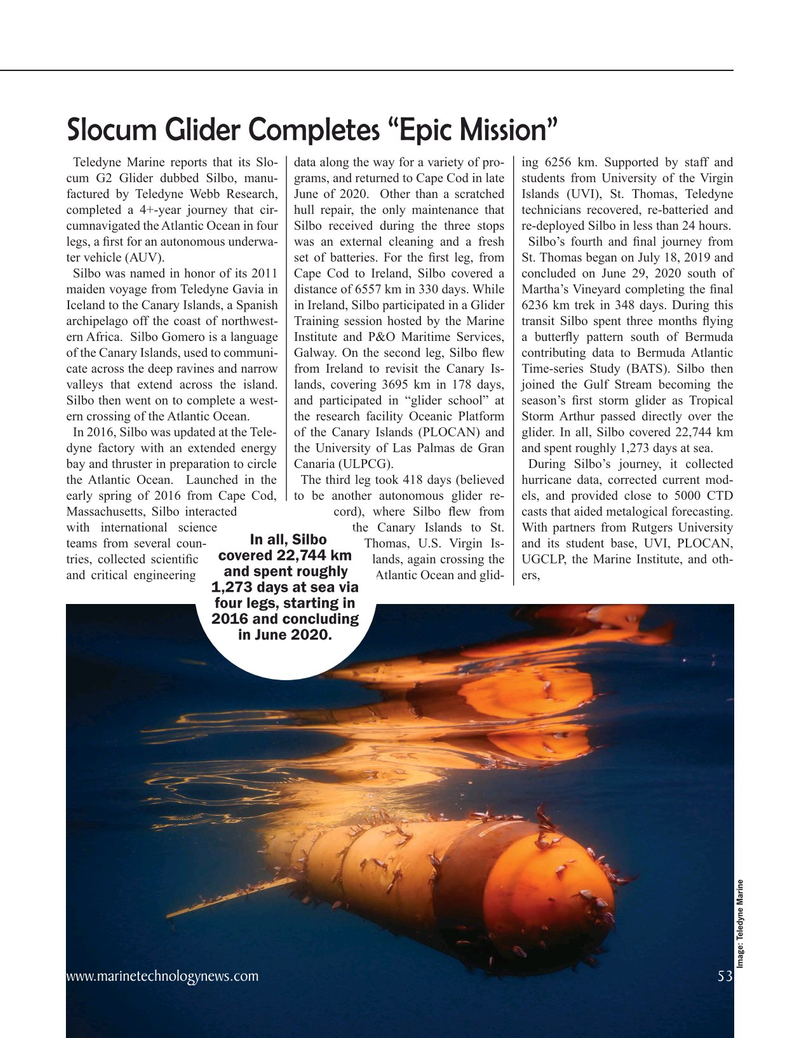
Page 53: of Marine Technology Magazine (September 2020)
Read this page in Pdf, Flash or Html5 edition of September 2020 Marine Technology Magazine
Slocum Glider Completes “Epic Mission”
Teledyne Marine reports that its Slo- data along the way for a variety of pro- ing 6256 km. Supported by staff and cum G2 Glider dubbed Silbo, manu- grams, and returned to Cape Cod in late students from University of the Virgin factured by Teledyne Webb Research, June of 2020. Other than a scratched Islands (UVI), St. Thomas, Teledyne completed a 4+-year journey that cir- hull repair, the only maintenance that technicians recovered, re-batteried and cumnavigated the Atlantic Ocean in four Silbo received during the three stops re-deployed Silbo in less than 24 hours. legs, a ? rst for an autonomous underwa- was an external cleaning and a fresh Silbo’s fourth and ? nal journey from ter vehicle (AUV). set of batteries. For the ? rst leg, from St. Thomas began on July 18, 2019 and
Silbo was named in honor of its 2011 Cape Cod to Ireland, Silbo covered a concluded on June 29, 2020 south of maiden voyage from Teledyne Gavia in distance of 6557 km in 330 days. While Martha’s Vineyard completing the ? nal
Iceland to the Canary Islands, a Spanish in Ireland, Silbo participated in a Glider 6236 km trek in 348 days. During this archipelago off the coast of northwest- Training session hosted by the Marine transit Silbo spent three months ? ying ern Africa. Silbo Gomero is a language Institute and P&O Maritime Services, a butter? y pattern south of Bermuda of the Canary Islands, used to communi- Galway. On the second leg, Silbo ? ew contributing data to Bermuda Atlantic cate across the deep ravines and narrow from Ireland to revisit the Canary Is- Time-series Study (BATS). Silbo then valleys that extend across the island. lands, covering 3695 km in 178 days, joined the Gulf Stream becoming the
Silbo then went on to complete a west- and participated in “glider school” at season’s ? rst storm glider as Tropical ern crossing of the Atlantic Ocean. the research facility Oceanic Platform Storm Arthur passed directly over the
In 2016, Silbo was updated at the Tele- of the Canary Islands (PLOCAN) and glider. In all, Silbo covered 22,744 km dyne factory with an extended energy the University of Las Palmas de Gran and spent roughly 1,273 days at sea. bay and thruster in preparation to circle Canaria (ULPCG). During Silbo’s journey, it collected the Atlantic Ocean. Launched in the The third leg took 418 days (believed hurricane data, corrected current mod- early spring of 2016 from Cape Cod, to be another autonomous glider re- els, and provided close to 5000 CTD
Massachusetts, Silbo interacted cord), where Silbo ? ew from casts that aided metalogical forecasting. with international science the Canary Islands to St. With partners from Rutgers University
In all, Silbo teams from several coun- Thomas, U.S. Virgin Is- and its student base, UVI, PLOCAN, covered 22,744 km tries, collected scienti? c lands, again crossing the UGCLP, the Marine Institute, and oth- and spent roughly and critical engineering Atlantic Ocean and glid- ers, 1,273 days at sea via four legs, starting in 2016 and concluding in June 2020.
Image: Teledyne Marine www.marinetechnologynews.com 53
MTR #7 (50-63).indd 53 9/11/2020 1:01:14 PM

 52
52

 54
54
